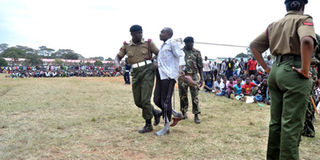NIS ‘knew of corruption’ in hiring of police officers

A police officer ejects a man who had no qualifications during the police recruitment exercise at NYS Headquarters in Nairobi County on July 14, 2014. PHOTO | GERALD ANDERSON
What you need to know:
- Mr Kamama and Ms Keino made the statements at a meeting of the committee and the commission Thursday in the on-going investigations into the controversial recruitment of trainees for the police service.
- At a meeting last week, the National Police Service Commission (NPSC) explained to committees the formula they developed to determine how many recruits would be picked from each tribe in a sub-county (the former districts).
The National Intelligence Service (NIS) knew about the existence of corrupt people waiting to influence the recruitment of police officers, National Security Committee chairman Asman Kamama has said.
At the same time, the Ethics and Anti-Corruption Commission vice-chairman, Ms Irene Keino, has ruled out the nullification of the entire recruitment since corruption did not take place in all the 289 enrolment centres.
Mr Kamama and Ms Keino made the statements at a meeting of the committee and the commission Thursday in the on-going investigations into the controversial recruitment of trainees for the police service.
The Tiaty MP said the National Intelligence Service should have informed the police and the anti-corruption body of the imminent “ambush” of the recruitment.
VERY CORRUPT SERVICE
“One week before, the gang of corrupt people sat down, appointed their agents and identified all those members (of the recruiting teams). It’s really strange that intelligence service was not able to tell you that this was going to take place,” said Mr Kamama.
“If we’re going to take pre-corrupt officers to those training colleges, what will happen? In 30 years, we’ll have a very corrupt police service,” he added.
At a meeting last week, the National Police Service Commission (NPSC) explained to committees the formula they developed to determine how many recruits would be picked from each tribe in a sub-county (the former districts).
To get the number of slots available for a tribe, they got the number of officers from that tribe in the service, divided it by the number of officers in the service and then multiplied it by 10,000, the number of police they wanted to recruit.
There were also measures to take care of 30 tribes with very low numbers in the police service and these were allocated 25 slots upfront, Mr Kitoo Kapchanga, the deputy director of personnel at the National Police Service, explained last week.
They were thus given a total of 1,000 slots upfront - 750 plus 250 to take care of those with very low numbers.
The rest of the slots were then shared amongst all Kenyan tribes, the marginalised ones included.
The calculations were based on the 2009 national census.
The recruitment teams were thus supplied with instructions on the exact number of members of tribes they were to pick from each of the 289 centres.
With the recruitment carried out by teams headed by the Officer Commanding Police Division in each sub-county, it was possible to know beforehand which officers would be in charge.
Ms Keino told the committee she had only received 41 complaints, which were being investigated.
The commission is also represented in the committee with members from the police and other agencies looking into the recruitment and whose verdict is expected Friday.
She said the commission would scrutinise the recruitment on a case by case basis.





